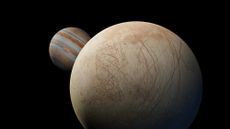NASA satellite tracks sand as it goes from the Sahara to the Amazon

Every year, millions of tons of Saharan dust flies 3,000 miles across the Atlantic to the Amazon basin, where it settles in and helps plants grow.
Since 2007, NASA's Cloud-Aerosol Lidar and Infrared Pathfinder Satellite Observation (CALIPSO) has been monitoring the particles as they travel from Africa to South America, and the plumes can be spotted from space. On average, 182 million tons of dust leaves Africa annually, and of that amount about 27 million tons make it to the Amazon. Once there, it replenishes phosphorous lost from surface runoff and flooding. "Using satellites to get a clear picture of dust is important for understand and eventually using computers to model where that dust will go now and in future climate scenarios," NASA research scientist Hongbin Yu said. —Catherine Garcia
Subscribe to The Week
Escape your echo chamber. Get the facts behind the news, plus analysis from multiple perspectives.

Sign up for The Week's Free Newsletters
From our morning news briefing to a weekly Good News Newsletter, get the best of The Week delivered directly to your inbox.
From our morning news briefing to a weekly Good News Newsletter, get the best of The Week delivered directly to your inbox.
Create an account with the same email registered to your subscription to unlock access.
Sign up for Today's Best Articles in your inbox
A free daily email with the biggest news stories of the day – and the best features from TheWeek.com
Catherine Garcia is night editor for TheWeek.com. Her writing and reporting has appeared in Entertainment Weekly and EW.com, The New York Times, The Book of Jezebel, and other publications. A Southern California native, Catherine is a graduate of the University of Redlands and the Columbia University Graduate School of Journalism.
-
 Cicada-geddon: the fungus that controls insects like 'zombies'
Cicada-geddon: the fungus that controls insects like 'zombies'Under The Radar Expert says bugs will develop 'hypersexualisation' despite their genitals falling off
By Chas Newkey-Burden, The Week UK Published
-
 'Voters know Biden and Trump all too well'
'Voters know Biden and Trump all too well'Instant Opinion Opinion, comment and editorials of the day
By Harold Maass, The Week US Published
-
 Is the Gaza war tearing US university campuses apart?
Is the Gaza war tearing US university campuses apart?Today's Big Question Protests at Columbia University, other institutions, pit free speech against student safety
By Joel Mathis, The Week US Published
-
 Blind people will listen to next week's total eclipse
Blind people will listen to next week's total eclipseSpeed Read While they can't see the event, they can hear it with a device that translates the sky's brightness into music
By Peter Weber, The Week US Published
-
 Melting polar ice is messing with global timekeeping
Melting polar ice is messing with global timekeepingSpeed Read Ice loss caused by climate change is slowing the Earth's rotation
By Peter Weber, The Week US Published
-
 An amphibian that produces milk?
An amphibian that produces milk?speed read Caecilians, worm-like amphibians that live underground, produce a milk-like substance for their hatchlings
By Peter Weber, The Week US Published
-
 Jupiter's Europa has less oxygen than hoped
Jupiter's Europa has less oxygen than hopedspeed read Scientists say this makes it less likely that Jupiter's moon harbors life
By Peter Weber, The Week US Published
-
 Why February 29 is a leap day
Why February 29 is a leap daySpeed Read It all started with Julius Caesar
By Peter Weber, The Week US Published
-
 US spacecraft nearing first private lunar landing
US spacecraft nearing first private lunar landingSpeed Read If touchdown is successful, it will be the first U.S. mission to the moon since 1972
By Peter Weber, The Week US Published
-
 Scientists create 'meaty' rice for eco-friendly protein
Scientists create 'meaty' rice for eco-friendly proteinSpeed Read Korean scientists have invented a new hybrid food, consisting of beef muscle and fat cells grown inside grains of rice
By Peter Weber, The Week US Published
-
 New images reveal Neptune and Uranus in different colours than originally thought
New images reveal Neptune and Uranus in different colours than originally thoughtSpeed Read Voyager 2 images from the 1980s led to 'modern misconception'
By Chas Newkey-Burden, The Week UK Published